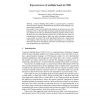Free Online Productivity Tools
i2Speak
i2Symbol
i2OCR
iTex2Img
iWeb2Print
iWeb2Shot
i2Type
iPdf2Split
iPdf2Merge
i2Bopomofo
i2Arabic
i2Style
i2Image
i2PDF
iLatex2Rtf
Sci2ools
166
Voted
SOFSEM
2009
Springer
2009
Springer
Expressiveness of Multiple Heads in CHR
Abstract. Constraint Handling Rules (CHR) is a general purpose, committedchoice declarative language which, differently from other similar languages, uses multi-headed (guarded) rules. In this paper we prove that multiple heads augment the expressive power of the language. In fact, we first show that restricting to single head rules affects the Turing completeness of CHR, provided that the underlying signature (for the constraint theory) does not contain function symbols. Next we show that, also when considering generic constraint theories, under some rather reasonable assumptions it is not possible to encode CHR (with multi-headed rules) into a single-headed CHR language while preserving the semantics of programs. As a corollary we obtain that, under these assumptions, CHR can be encoded neither in (constraint) logic programming nor in pure Prolog.
Constraint Handling Rules | Generic Constraint Theories | Single-headed Chr Language | SOFSEM 2009 | Theoretical Computer Science |
Related Content
| Added | 17 Mar 2010 |
| Updated | 17 Mar 2010 |
| Type | Conference |
| Year | 2009 |
| Where | SOFSEM |
| Authors | Cinzia Di Giusto, Maurizio Gabbrielli, Maria Chiara Meo |
Comments (0)

